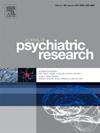囤积障碍伴注意缺陷/多动障碍患者的自发活动和功能连通性
IF 3.7
2区 医学
Q1 PSYCHIATRY
引用次数: 0
摘要
尽管最近的研究表明,囤积症(HD)和注意力缺陷/多动障碍(ADHD)之间存在重要的联系,但没有神经影像学研究调查ADHD合并症患者与非ADHD患者之间的差异。本研究探讨了HD的区域自发活动和功能连通性,重点研究了ADHD的合并症。静息状态功能磁共振成像(MRI)数据来自24例HD患者和31例健康人。我们使用低频波动的分数幅度(fALFF)来研究组间差异。fALFF中改变的区域被用作功能连通性分析的种子,我们在三组之间进行了组比较:健康对照组(hc), HD伴ADHD (HD +ADHD)和HD无ADHD (HD -ADHD)。与hcc患者相比,HD患者右侧额下回(IFG)的fALFF减少。功能连通性分析显示,与hcc相比,HD +ADHD患者IFG和背外侧前额叶皮质(DLPFC)之间的功能连通性降低,而HD -ADHD组介于HD +ADHD和hcc组之间。总之,HD患者改变了IFG的自发活性。此外,HD + ADHD患者IFG和DLPFC之间的功能连通性显著降低。我们的研究结果表明,可能需要区分HD+ADHD的亚组,以确定HD的新的神经生物学模型,从而指导未来的治疗策略。本文章由计算机程序翻译,如有差异,请以英文原文为准。
Spontaneous activity and functional connectivity in patients with hoarding disorder comorbid with attention-deficit/hyperactive disorder
Despite recent studies suggesting an important association of hoarder disorder (HD) and attention-deficit/hyperactive disorder (ADHD), no neuroimaging study has investigated the differences between patients with HD comorbid with ADHD and those without ADHD. This study investigated the regional spontaneous activity and functional connectivity in HD, focusing on the comorbidity with ADHD.
Resting-state functional magnetic resonance imaging (MRI) data were obtained from 24 patients with HD and 31 healthy individuals. We investigated the group differences using the fractional amplitude of low-frequency fluctuation (fALFF). The altered regions in the fALFF were used as seeds in a functional connectivity analysis where we conducted group comparisons among the three groups: healthy controls (HCs), HD with ADHD (HD +ADHD), and HD without ADHD (HD -ADHD).
Compared to HCs, patients with HD had a reduced fALFF in the right inferior frontal gyrus (IFG). Functional connectivity analysis revealed that patients with HD + ADHD had reduced functional connectivity between the IFG and dorsolateral prefrontal cortex (DLPFC) compared to HCs, while the HD -ADHD group was intermediate level between HD +ADHD and HCs groups.
In conclusion, patients with HD have altered spontaneous activity of the IFG. Additionally, patients with HD + ADHD had significantly reduced functional connectivity between the IFG and the DLPFC. Our findings suggest the potential need to distinguish between subgroups of HD+ADHD to identify novel neurobiological models of HD that could guide future therapeutic strategies.
求助全文
通过发布文献求助,成功后即可免费获取论文全文。
去求助
来源期刊

Journal of psychiatric research
医学-精神病学
CiteScore
7.30
自引率
2.10%
发文量
622
审稿时长
130 days
期刊介绍:
Founded in 1961 to report on the latest work in psychiatry and cognate disciplines, the Journal of Psychiatric Research is dedicated to innovative and timely studies of four important areas of research:
(1) clinical studies of all disciplines relating to psychiatric illness, as well as normal human behaviour, including biochemical, physiological, genetic, environmental, social, psychological and epidemiological factors;
(2) basic studies pertaining to psychiatry in such fields as neuropsychopharmacology, neuroendocrinology, electrophysiology, genetics, experimental psychology and epidemiology;
(3) the growing application of clinical laboratory techniques in psychiatry, including imagery and spectroscopy of the brain, molecular biology and computer sciences;
 求助内容:
求助内容: 应助结果提醒方式:
应助结果提醒方式:


